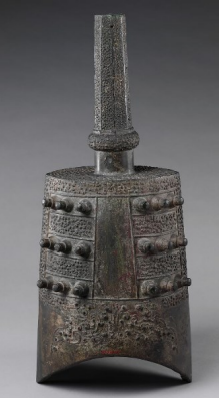2.7: Ritual Changes in the Spring and Autumn Period
- Page ID
- 135205
Since ritual was so central to political life, changes in relations of the Zhou feudal lords were echoed in and affected by the ritual realm. Around 600, ancestral ritual among the aristocracy changed from an intimate family rite to something more like a performance. There were musical changes: group singing was replaced by loud bell music played by performers. In addition, aristocrats adopted rituals that were inappropriate to their hereditary status, in order to show off and increase their power that way. In other ways, too, political ambition was on display. Tombs of great lords, instead of being underground, were built up into high, imposing layered towers. Instead of the ranked aristocracy being closely connected with one another, over time the rulers of some big states were exalted far above the rest of the nobles in their states – their relatives. The gap between the lords and everyone else became enormous.

At the same time, ancestral ritual focused more on the living and less on the ancestral spirits. The feudal lords had bronze ritual vessels made bigger, with more dramatic designs appropriate for viewing from afar, which suggests larger audiences. Here are key changes:
|
Western Zhou, before about 600 BC |
Eastern Zhou, after about 600 BC |
|---|---|
|
Smaller bronze vessels |
Larger vessels |
|
More delicate decoration |
More dramatic decoration |
|
Focus of the ritual is ancestors: offering wine, honor, and food in exchange for blessings. |
Focus of the ritual – sometimes explicitly – is the living community. |
|
Inscriptions say the vessel is for use in sacrifices to a specific ancestor (dedicatee). |
Inscriptions say the vessel is for the use of the donor who commissioned the vessel. |
|
“Statement of past merit” section is excerpted from official documents of the service to the king or other patron that earned the donor the right to cast the vessel. |
“Statement of past merit” section recites a list of glorious ancestors to show them off – to others. |
As shared ritual tended toward performance, the lower-ranking members of aristocratic families were relegated to the back of the room. There they developed a critical habit of mind, historian Edward Shaughnessy has argued. While early hymns in the Book of Odes praised the Zhou rulers and feudal lords, later poems also criticize lords. Poets developed ways to observe the complex interactions of animals and plants in the natural world and used such images to
display their observations of the complex emotions and relationships of the human world. Such critiques brought new salience to the individual intellectual’s mind, and those thinking people observed ritual more clearly. From the back of the room, those carrying out ritual looked more like actors than worshippers.
Insincerity became thinkable. Whereas the Shang King’s duties had been external – he had to read bones, kill the calf, spill bones, etc. – there were now the beginnings of a concern with the mindset of the ritual practitioner.13 Divisions among the elite created a new kind of individual consciousness, an explicit focus on interior sincerity as well as exterior performance.


